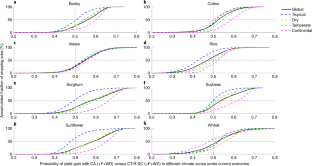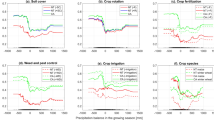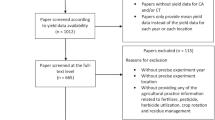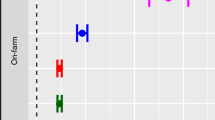Abstract
Conservation agriculture (CA) is being promoted as a set of management practices that can sustain crop production while providing positive environmental benefits. However, its impact on crop productivity is hotly debated, and how this productivity will be affected by climate change remains uncertain. Here we compare the productivity of CA systems and their variants on the basis of no tillage versus conventional tillage systems for eight major crop species under current and future climate conditions using a probabilistic machine-learning approach at the global scale. We reveal large differences in the probability of yield gains with CA across crop types, agricultural management practices, climate zones and geographical regions. For most crops, CA performed better in continental, dry and temperate regions than in tropical ones. Under future climate conditions, the performance of CA is expected to mostly increase for maize over its tropical areas, improving the competitiveness of CA for this staple crop.
This is a preview of subscription content, access via your institution
Access options
Access Nature and 54 other Nature Portfolio journals
Get Nature+, our best-value online-access subscription
$29.99 / 30 days
cancel any time
Subscribe to this journal
Receive 12 print issues and online access
$209.00 per year
only $17.42 per issue
Buy this article
- Purchase on Springer Link
- Instant access to full article PDF
Prices may be subject to local taxes which are calculated during checkout





Similar content being viewed by others
Data availability
The dataset10 is made fully available and described in a data paper11. The dataset can be accessed using the following link: https://doi.org/10.6084/m9.figshare.12155553.
Code availability
All the R and MATLAB codes are available in figshare and can be accessed through the link https://doi.org/10.6084/m9.figshare.14427977 or on request from the corresponding author.
References
Bisht, J. K, Meena, V. S, Mishra, P. K. & Pattanayak, A. (eds) Conservation Agriculture: An Approach to Combat Climate Change in Indian Himalaya (Springer, 2016).
Farooq, M. & Siddique, K. H. M. (eds) Conservation Agriculture (Springer, 2015).
Giller, K. E. et al. Beyond conservation agriculture. Front. Plant Sci. 6, 870 (2015).
Jat, S. L. et al. Differential response from nitrogen sources with and without residue management under conservation agriculture on crop yields, water-use and economics in maize-based rotations. Field Crops Res. 236, 96–110 (2019).
Steward, P. R. et al. The adaptive capacity of maize-based conservation agriculture systems to climate stress in tropical and subtropical environments: a meta-regression of yields. Agric. Ecosyst. Environ. 251, 194–202 (2018).
Pittelkow, C. M. et al. When does no-till yield more? A global meta-analysis. Field Crops Res. 183, 156–168 (2015).
Conservation Agriculture (FAO, 2020); http://www.fao.org/conservation-agriculture/en/
Pittelkow, C. M. et al. Productivity limits and potentials of the principles of conservation agriculture. Nature 517, 365–368 (2015).
Nichols, V., Verhulst, N., Cox, R. & Govaerts, B. Weed dynamics and conservation agriculture principles: a review. Field Crops Res. 183, 56–68 (2015).
Su, Y., Gabrielle, B. & Makowski, D. A global dataset for crop production under conventional tillage and no tillage practice. figshare https://doi.org/10.6084/m9.figshare.12155553 (2020).
Su, Y., Gabrielle, B. & Makowski, D. A global dataset for crop production under conventional tillage and no tillage systems. Sci. Data 8, 33 (2020).
University of Delaware Air Temperature & Precipitation (NOAA/OAR/ESRL PSL, 2020); https://www.esrl.noaa.gov/psd/data/gridded/data.UDel_AirT_Precip.html
CPC Global Daily Temperature (NOAA/OAR/ESRL PSL, 2020); https://www.esrl.noaa.gov/psd/data/gridded/data.cpc.globaltemp.html
Martens, B. et al. GLEAM v3: satellite-based land evaporation and root-zone soil moisture. Geosci. Model Dev. 10, 1903–1925 (2017).
Miralles, D. G. et al. Global land-surface evaporation estimated from satellite-based observations. Hydrol. Earth Syst. Sci. 15, 453–469 (2011).
Crop Calendar Dataset: netCDF 5 degree (Univ. of Wisconsin-Madison, 2020); https://nelson.wisc.edu/sage/data-and-models/crop-calendar-dataset/netcdf0-5degree.php
Ho, T. K. Random decision forests. In Proc. 3rd International Conference on Document Analysis and Recognition 278–282 (IEEE, 1995).
Kottek, M., Grieser, J., Beck, C., Rudolf, B. & Rubel, F. World Map of the Köppen–Geiger climate classification updated. Meteorol. Z. 15, 259–263 (2006).
Laborde, J. P., Wortmann, C. S., Blanco-Canqui, H., Baigorria, G. A. & Lindquist, J. L. Identifying the drivers and predicting the outcome of conservation agriculture globally. Agric. Syst. 177, 102692 (2020).
Su, Z. et al. Effects of conservation tillage practices on winter wheat water-use efficiency and crop yield on the Loess Plateau, China. Agric. Water Manag. 87, 307–314 (2007).
van Wie, J. B., Adam, J. C. & Ullman, J. L. Conservation tillage in dryland agriculture impacts watershed hydrology. J. Hydrol. 483, 26–38 (2013).
Shukla, M. K., Lal, R. & Ebinger, M. Tillage effects on physical and hydrological properties of a typica argiaquoll in Central Ohio. Soil Sci. 168, 802–811 (2003).
Shen, Y., McLaughlin, N., Zhang, X., Xu, M. & Liang, A. Effect of tillage and crop residue on soil temperature following planting for a Black soil in Northeast China. Sci. Rep. 8, 4500 (2018).
Zuazo, V. H. D. & Pleguezuelo, C. R. R. Soil-erosion and runoff prevention by plant covers. A review. Agron. Sustain. Dev. 28, 65–86 (2008).
Shaxson, F. & Barber, R. Optimizing Soil Moisture for Plant Production: The Significance of Soil Porosity (FAO, 2003).
Derpsch, R., Sidiras, N. & Roth, C. H. Results from studies made from 1977–1984 to control erosion by no-tillage techniques in Paraná, Brazil. Soil Tillage Res. 8, 253–263 (1986).
TerAvest, D., Carpenter-Boggs, L., Thierfelder, C. & Reganold, J. P. Crop production and soil water management in conservation agriculture, no-till, and conventional tillage systems in Malawi. Agric. Ecosyst. Environ. 212, 285–296 (2015).
Page, K. L., Dang, Y. P. & Dalal, R. C. The ability of conservation agriculture to conserve soil organic carbon and the subsequent impact on soil physical, chemical, and biological properties and yield. Front. Sust. Food Syst. 4, 31 (2020).
Halvorson, A. D. et al. Spring wheat response to tillage and nitrogen fertilization in rotation with sunflower and winter wheat. Agron. J. 92, 136–144 (2000).
Radford, B. J. & Thornton, C. M. Effects of 27 years of reduced tillage practices on soil properties and crop performance in the semi-arid subtropics of Australia. Int. J. Energy Environ. Econ. 19, 565 (2011).
García-Palacios, P., Alarcón, M. R., Tenorio, J. L. & Moreno, S. S. Ecological intensification of agriculture in drylands. J. Arid. Environ. 167, 101–105 (2019).
Scopel, E. et al. Conservation agriculture cropping systems in temperate and tropical conditions, performances and impacts. A review. Agron. Sustain. Dev. 33, 113–130 (2013).
Thierfelder, C. & Wall, P. C. Investigating conservation agriculture (CA) systems in Zambia and Zimbabwe to mitigate future effects of climate change. J. Crop Improve. 24, 113–121 (2010).
Lal, R. The role of residues management in sustainable agricultural systems. J. Sustain. Agric. 5, 51–78 (1995).
Thierfelder, C. et al. Complementary practices supporting conservation agriculture in southern Africa. A review. Agron. Sustain. Dev. 38, 16 (2018).
Corbeels, M., Naudin, K., Whitbread, A. M., Kühne, R. & Letourmy, P. Limits of conservation agriculture to overcome low crop yields in sub-Saharan Africa. Nat. Food 1, 447–454 (2020).
Smith, P., Powlson, D. S., Glendining, M. J. & Smith, J. U. Preliminary estimates of the potential for carbon mitigation in European soils through no‐till farming. Glob. Change Biol. 4, 679–685 (1998).
Williams, A. et al. A regionally-adapted implementation of conservation agriculture delivers rapid improvements to soil properties associated with crop yield stability. Sci. Rep. 8, 8467 (2018).
Kassam, A., Friedrich, T., Shaxson, F. & Pretty, J. The spread of conservation agriculture: justification, sustainability and uptake. Int. J. Agric. Sustain. 7, 292–320 (2009).
Hobbs, P. R., Sayre, K. & Gupta, R. The role of conservation agriculture in sustainable agriculture. Phil. Trans. R. Soc. B 363, 543–555 (2008).
Govaerts, B. et al. Conservation agriculture as a sustainable option for the central Mexican highlands. Soil Tillage Res. 103, 222–230 (2009).
Su, Y., Gabrielle, B., Beillouin, D. & Makowski, D. High probability of yield gain through conservation agriculture in dry regions for major staple crops. Sci. Rep. 11, 3344 (2021).
Soil Texture Map (Univ. of Tokyo, 2020); http://hydro.iis.u-tokyo.ac.jp/~sujan/research/gswp3/soil-texture-map.html
Breiman, L. Random Forests. Mach. Learn. 45, 5–32 (2001).
Frieler, K. et al. Assessing the impacts of 1.5 °C global warming—simulation protocol of the Inter-Sectoral Impact Model Intercomparison Project (ISIMIP2b). Geosci. Model Dev. 10, 4321–4345 (2017).
ESGF Project (Lawrence Livermore National Laboratory, 2020); https://esgf-node.llnl.gov/projects/esgf-llnl/
Portmann, F. T., Siebert, S. & Döll, P. MIRCA2000-Global monthly irrigated and rainfed crop areas around the year 2000: a new high-resolution data set for agricultural and hydrological modeling. Global Biogeochem. Cycles 24, GB1011 (2010).
Acknowledgements
This work was supported by the ANR under the ‘Investissements d’avenir’ programme with the reference ANR-16-CONV-0003 (CLAND) and by the INRAE CIRAD meta-program ‘GloFoods’.
Author information
Authors and Affiliations
Contributions
Y.S. wrote the main manuscript text and B.G. and D.M. modified it. Y.S., B.G. and D.M. worked together to prepare the figures and tables. Y.S. collected the data. Y.S., B.G. and D.M. designed and built the models to process the data. Y.S. worked on the model cross-validation. All authors reviewed the manuscripts.
Corresponding author
Ethics declarations
Competing interests
The authors declare no competing interests.
Additional information
Peer review information Nature Climate Change thanks Marc Corbeels, Krishna Naudin, Christian Thierfelder and the other, anonymous, reviewer(s) for their contribution to the peer review of this work.
Publisher’s note Springer Nature remains neutral with regard to jurisdictional claims in published maps and institutional affiliations.
Extended data
Extended Data Fig. 1 Accumulated fraction of the cropping area as a function of the probability of yield gain under CA (+F+WD -Irrigation) versus CT–R–SC (+F+WD -Irrigation) systems in different climate regions.
Accumulated fraction of the cropping area as a function of the probability of yield gain under CA (+F+WD – Irrigation) versus CT–R–SC with fertilization (+F) and weed and pest control (+WD) without irrigation (–Irrigation) for eight major crops (a–h) and different climate zones. The results are based on the average climate conditions over 2021–2020 simulated by the Ipsl-cm5a-lr climate model and RCP 4.5 scenario.
Extended Data Fig. 2 Relative importance ranking of the model inputs.
The importance was defined by the mean decrease in accuracy in the ‘cforest’ model. Where ‘PB’ indicates precipitation balance over crop growing season; ‘Tmax’ indicates maximum air temperature over crop growing season;’Tave’ indicates average air temperature over crop growing season; ‘Tmin’ indicates minimum air temperature over crop growing season; ‘Crop’ indicates the crop species;’ST’ indicates soil texture; ‘SCNT’ indicates soil cover management under the variants of no tillage systems; ‘SCCT’ indicates soil cover management under CT systems; ‘RNT’ indicates crop rotation management under the variants of no tillage systems; ‘RCT’ indicates crop rotation management under CT systems; ‘FNT’ indicates management of crop fertilization under the variants of no tillage systems; ‘FCT’ indicates crop management of crop fertilization under CT systems; ‘WDNT’ indicates management of weed and pest control under the variants of no tillage systems; ‘WDCT’ indicates crop management of weed and pest control under CT systems.
Extended Data Fig. 3 The accumulated fraction of the cropping area in different level of change on the probability of yield gain under CA (+F+WD) versus CT–R–SC (+F+WD) under different crops, climate models and RCP scenarios.
The accumulated fraction of the cropping area in different level of change on the probability of yield gain under CA (+F+WD) versus CT–R–SC (+F+WD) for different crops, climate models and RCP scenarios. The results are based on the average climate data in different RCP scenarios (RCP 2.6, RCP 4.5, RCP 6.0, RCP 8.5) in Ipsl-cm5a-lr model, and RCP 4.5 scenario in different climate models (Ipsl-cm5a-lr, Gfdl-esm2m, Hadgem2-es, Miroc5) for both current (2021–2020) and future (2051–2060) scenarios.
Extended Data Fig. 4 Distributions of experiment site for each crop.
This map and the corresponding dataset are presented in ref. 11, 42. This figure was generated by MATLAB R2020a (Version 9.8.0.1451342, https://fr.mathworks.com/products/matlab.html). In this meta-dataset (ref. 11), 4403 paired yield observations were extracted from NT and CT for 8 major crop species, including 370 observations for barley (232 observations for spring barley and 138 for winter barley), 94 observations for cotton, 1690 observations for maize, 195 observation for rice, 160 observations for sorghum, 583 observations for soybean, 61 observations for sunflower, 1250 observations for wheat (1041 observations for winter wheat and 209 observations for spring wheat) in 50 countries from 1980 to 2017.
Supplementary information
Supplementary Information
Supplementary Table 1, Figs. 1–8 and references.
Rights and permissions
About this article
Cite this article
Su, Y., Gabrielle, B. & Makowski, D. The impact of climate change on the productivity of conservation agriculture. Nat. Clim. Chang. 11, 628–633 (2021). https://doi.org/10.1038/s41558-021-01075-w
Received:
Accepted:
Published:
Issue Date:
DOI: https://doi.org/10.1038/s41558-021-01075-w
This article is cited by
-
A 10-m annual grazing intensity dataset in 2015–2021 for the largest temperate meadow steppe in China
Scientific Data (2024)
-
Synthesising results of meta-analyses to inform policy: a comparison of fast-track methods
Environmental Evidence (2023)
-
Is Risk a Limit or an Opportunity to Mitigate Greenhouse Gas Emissions? The Case of fertilization in Agriculture
Environmental Modeling & Assessment (2023)
-
The effects of climate change and phenological variation on agricultural production and its risk pattern in the black soil area of northeast China
Journal of Geographical Sciences (2023)
-
Delayed use of bioenergy crops might threaten climate and food security
Nature (2022)



